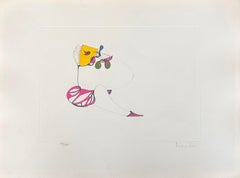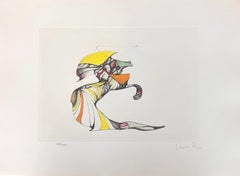Frédéric Bouché Art
to
1
Overall Width
to
Overall Height
to
1
1
1
1
1
1
1
1
7,820
5,167
2,504
1,501
1
Artist: Frédéric Bouché
Surrealist Horse and Rider - Handsigned lithograph
By Frédéric Bouché
Located in Paris, IDF
Frederic BOUCHE
Surrealist Horse and Rider
Original lithograph
Handsigned in pencil
Numbered / 125 copies
On Japan paper 65 x 50 cm (c. 26 x 20 in)
Excellent condition
Category
Late 20th Century Surrealist Frédéric Bouché Art
Materials
Lithograph
Related Items
Ma fortune - Hand-signed numbered lithograph by Leonor Fini, Surrealist, 1975
By Leonor Fini
Located in New York, NY
Leonor Fini
Ma fortune, 1975
Colored etching on Arches paper
11 × 15 in 28 × 38 cm
Limited edition of 185
Condition: Excellent condition
Category
1970s Surrealist Frédéric Bouché Art
Materials
Lithograph
Autumn afternoons - Hand-signed numbered lithograph Leonor Fini Surrealist, 1975
By Leonor Fini
Located in New York, NY
Leonor Fini
Pendant les après-midi d'automne, 1975
Colored etching on Arches paper
11 × 15 in 28 × 38 cm
Limited edition of 185
Condition: Excellent condition
Category
1970s Surrealist Frédéric Bouché Art
Materials
Lithograph
Henry Moore - Original Lithograph
By Henry Moore
Located in Collonge Bellerive, Geneve, CH
Henry Moore - Original Lithograph
1977
Dimensions: 32 x 24 cm
From the art review XXe siècle
Unsigned and unumbered as issued
Category
1970s Surrealist Frédéric Bouché Art
Materials
Lithograph
Du fil à retordre - Hand-signed numbered lithograph Leonor Fini Surrealist, 1975
By Leonor Fini
Located in New York, NY
Leonor Fini
Du fil à retordre, 1975
Colored etching on Arches paper
11 × 15 in 28 × 38 cm
Limited edition of 185
Condition: Excellent condition
Category
1970s Surrealist Frédéric Bouché Art
Materials
Lithograph
Salvador Dali - Cherries - Original Hand-Signed Lithograph
By Salvador Dalí
Located in Collonge Bellerive, Geneve, CH
Salvador Dali - Cherries - Original Hand-Signed Lithograph
Dimensions: P. 57 x 37 cm
Sheet: 75 x 56 cm
Handsigned
Edition: EC.d (collaborator edition "d")
Excellent Condition
Refer...
Category
1960s Surrealist Frédéric Bouché Art
Materials
Lithograph
H 29.53 in W 22.05 in D 0.4 in
Large Surrealist Photo Realist Silkscreen Lithograph Print Swan Dreams
Located in Surfside, FL
Born in Stoke-on-Trent in 1953, Frederick Phillips studied Fine Art at Burslem College of Art when Arthur Berry was Head of the Fine Art (Painting) ...
Category
1990s Surrealist Frédéric Bouché Art
Materials
Lithograph, Screen
American Trotting Horses No. I
By Salvador Dalí
Located in Paonia, CO
American Trotting Horses No.1 is from the series “The World Of Currier And Ives as interpreted by Salvador Dali” published by Phyllis...
Category
1970s Surrealist Frédéric Bouché Art
Materials
Lithograph
Marino Marini - Horses - Original Lithograph
By Marino Marini
Located in Collonge Bellerive, Geneve, CH
Marino Marini - Horses - Original Lithograph
1951
Dimensions: 32 x 24 cm
From the art review XXe siècle
Unsigned and unumbered as issued
Category
1950s Surrealist Frédéric Bouché Art
Materials
Lithograph
Bucéphale
By Salvador Dalí
Located in OPOLE, PL
Salvador Dali (1904-1989) - Bucéphale
Lithograph from 1970.
Dimensions of work: 68 x 50 cm
On B.F.K Rives paper as stated in the Field catalogue.
Reference: Field 72-6G
The work...
Category
1970s Surrealist Frédéric Bouché Art
Materials
Etching, Aquatint, Lithograph
Max Ernst - Abstract Birds - Original Lithograph
By Max Ernst
Located in Collonge Bellerive, Geneve, CH
Max Ernst - Birds - Original Lithograph
Birds, 1962
Dimensions: 32 x 24 cm
From the art review XXe siècle
Unsigned and unumbered as issued
Category
1960s Surrealist Frédéric Bouché Art
Materials
Lithograph
Max Ernst - Birds - Original Lithograph
By Max Ernst
Located in Collonge Bellerive, Geneve, CH
Max Ernst - Birds - Original Lithograph
Birds, 1964 (BNF, 63)
Dimensions: 32 x 24 cm
Revue Art de France
ax Ernst was born in Bruhl, a place near Cologne, in Germany. He was raised in a strict Catholic family, and both of his parents were disciplinarians who were dedicated to training their children into God-fearing and talented individuals. Although his father was deaf, Ernst learned so much from him, particularly when it comes to painting. In fact, much of his early years were lived under the inspiration of his father who was also a teacher. He was the one who introduced painting to Ernst at an early age.
In 1914, Ernst attended the University of Bonn where he studied philosophy. However, he eventually dropped out of school because he was more interested in the arts. He claimed that his primary sources of interest included anything that had something to do with painting. Moreover, he became fascinated with psychology, among other subjects in school.
Primarily, Ernst's love for painting was the main reason why he became deeply interested with this craft and decided to pursue it later on in his life. During his early years, he became familiar with the works of some of the greatest artists of all time including Claude Monet, Paul Cezanne and Vincent van Gogh. He was also drawn to themes such as fantasy and dream imagery, which were among the common subjects of the works of Giorgio de Chirico.
During World War I, Ernst was forced to join the German Army, and he became a part of the artillery division that exposed him greatly to the drama of warfare. A soldier in the War, Ernst emerged deeply traumatized and highly critical of western culture. These charged sentiments directly fed into his vision of the modern world as irrational, an idea that became the basis of his artwork. Ernst's artistic vision, along with his humor and verve come through strongly in his Dada and Surrealists works; Ernst was a pioneer of both movements.
It was Ernst's memories of the war and his childhood that helps him create absurd, yet interesting scenes in his artworks. Soon, he took his passion for the arts seriously when he returned to Germany after the war. With Jean Arp, a poet and artist, Ernst formed a group for artists in Cologne. He also developed a close relationship with fellow artists in Paris who propagated Avant-Garde artworks.
In 1919, Ernst started creating some of his first collages, where he made use of various materials including illustrated catalogs and some manuals that produced a somewhat futuristic image. His unique masterpieces allowed Ernst to create his very own world of dreams and fantasy, which eventually helped heal his personal issues and trauma. In addition to painting and creating collages, Ernst also edited some journals. He also made a few sculptures that were rather queer in appearance.
In 1920s, influenced by the writings of psychologist Sigmund Freud, the literary, intellectual, and artistic movement called Surrealism sought a revolution against the constraints of the rational mind; and by extension, they saw the rules of a society as oppressive. Surrealism also embraces a Marxist ideology that demands an orthodox approach to history as a product of the material interaction of collective interests, and many renown Surrealism artists later on became 20th century Counterculture symbols such as Marxist Che Guevara. In 1922 Ernst moved to Paris, where the surrealists were gathering around Andre Breton. In 1923 Ernst finished Men Shall Know Nothing of This, known as the first Surrealist painting. Ernst was one of the first artists who apply The Interpretation of Dreams by Freud to investigate his deep psyche in order to explore the source of his own creativity. While turning inwards unto himself, Ernst was also tapping into the universal unconscious with its common dream imagery.
Despite his strange styles, Ernst gained quite a reputation that earned him some followers throughout his life. He even helped shape the trend of American art during the mid-century, thanks to his brilliant and extraordinary ideas that were unlike those of other artists during his time. Ernst also became friends with Peggy Guggenheim, which inspired him to develop close ties with the abstract expressionists.
When Ernst lived in Sedona, he became deeply fascinated with the Southwest Native American navajo art. In fact, the technique used in this artwork inspired him and paved the way for him to create paintings that depicted this style. Thus, Ernst became a main figure of this art technique, including the rituals and spiritual traditions included in this form of art. Pollock, aside from the other younger generations of abstract expressionists, was also inspired by sand painting of the Southwest...
Category
1960s Surrealist Frédéric Bouché Art
Materials
Lithograph
Max Ernst - Elektra - Lithograph
By Max Ernst
Located in Collonge Bellerive, Geneve, CH
Max Ernst - Elektra
Lithograph
1939
Dimensions: 32 x 24 cm
Signed in the plate
From XXe siècle
Unsigned and unumbered as issued
Category
1930s Surrealist Frédéric Bouché Art
Materials
Lithograph
Previously Available Items
Seated Surrealist Model - Handsigned lithograph
By Frédéric Bouché
Located in Paris, IDF
Frederic BOUCHE
Seated Surrealist Model
Original lithograph
Handsigned in pencil
Numbered / 75 copies
On Japan paper 76 x 54 cm (c. 30 x 22 in)
Excellent condition
Category
Late 20th Century Surrealist Frédéric Bouché Art
Materials
Lithograph
Seated Surrealist Model - Handsigned lithograph
By Frédéric Bouché
Located in Paris, IDF
Frederic BOUCHE
Seated Surrealist Model
Original lithograph
Handsigned in pencil
Numbered / 75 copies
On Japan paper 76 x 54 cm (c. 30 x 22 in)
Excellent condition
Category
Late 20th Century Surrealist Frédéric Bouché Art
Materials
Lithograph
Surrealist Horse and Rider - Handsigned lithograph
By Frédéric Bouché
Located in Paris, IDF
Frederic BOUCHE
Surrealist Horse and Rider
Original lithograph
Handsigned in pencil
Numbered / 125 copies
On Japan paper 65 x 50 cm (c. 26 x 20 in)
Excellent condition
Category
Late 20th Century Surrealist Frédéric Bouché Art
Materials
Lithograph
Frédéric Bouché art for sale on 1stDibs.
Find a wide variety of authentic Frédéric Bouché art available for sale on 1stDibs. You can also browse by medium to find art by Frédéric Bouché in lithograph and more. Much of the original work by this artist or collective was created during the 20th century and is mostly associated with the Surrealist style. Not every interior allows for large Frédéric Bouché art, so small editions measuring 20 inches across are available. Customers who are interested in this artist might also find the work of Francis de Saint-Genies, Leonor Fini, and Fred Deux. Frédéric Bouché art prices can differ depending upon medium, time period and other attributes. On 1stDibs, the price for these items starts at $216 and tops out at $216, while the average work can sell for $216.

